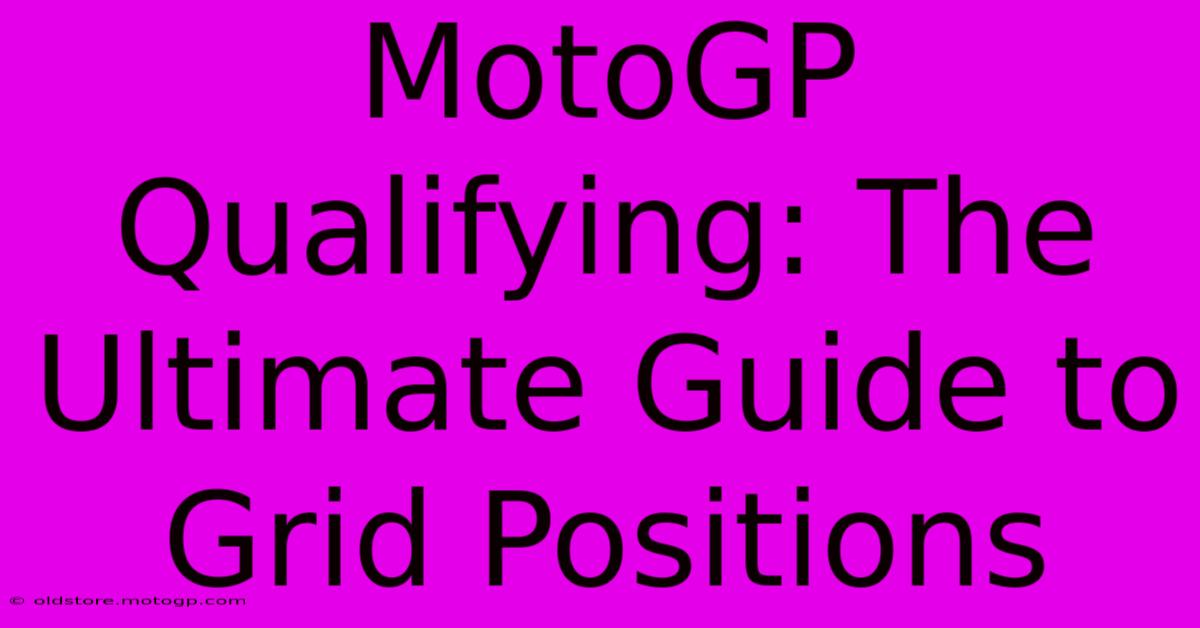MotoGP Qualifying: The Ultimate Guide To Grid Positions

Table of Contents
MotoGP Qualifying: The Ultimate Guide to Grid Positions
MotoGP, the pinnacle of motorcycle racing, delivers heart-stopping action every weekend. But before the lights go out and the bikes roar down the track, there's the crucial battle for grid positions: qualifying. Understanding how MotoGP qualifying works is key to appreciating the race itself, and this guide will break down every aspect, from the format to the strategies employed by the riders and teams.
Understanding the MotoGP Qualifying Format
The current MotoGP qualifying format is designed to create excitement and drama, offering a thrilling spectacle for fans and high stakes for the riders. It's a multi-stage process culminating in the all-important grid positions for the race.
Q1: The Fight for Q2
The qualifying process begins with Q1 (Qualifying 1). This session involves the ten slowest riders from the combined Free Practice sessions (FP1, FP2, and FP3). These riders have a limited time – typically 15 minutes – to set the fastest lap time possible. Only the two fastest riders from Q1 progress to the next stage, Q2. The pressure is immense; a single mistake can be devastating. Strategy is vital here, with some riders opting to push hard from the start, while others might wait to avoid traffic and tire wear.
Q2: The Battle for Pole Position
Q2 (Qualifying 2) features the remaining 15 riders from the combined Free Practice sessions (the top 10 and the two fastest from Q1). This 15-minute session is fiercely competitive, with every rider aiming for pole position – the coveted first starting slot on the grid. The fastest rider from Q2 secures pole position, boasting a significant advantage heading into the race. Overtaking in MotoGP is challenging, making grid position critically important.
The Importance of Grid Position in MotoGP
The importance of securing a strong grid position cannot be overstated. A good starting spot offers several key advantages:
- Clean Start: Avoiding the chaos of the first corner is crucial. A good grid position minimizes the risk of collisions and allows riders to establish a strong early race position.
- Track Position: In MotoGP, track position is king. The leading riders often dictate the race pace, and a strong starting position helps riders gain and maintain a leading position.
- Race Strategy: A good starting position allows riders to execute their race strategy more effectively, particularly in terms of tire management and overtaking opportunities.
Key Factors Influencing Qualifying Performance
Several factors contribute to a rider's qualifying performance:
- Bike Setup: The motorcycle's setup plays a crucial role in determining lap times. Teams spend countless hours fine-tuning the bike's settings to optimize performance during qualifying.
- Tire Choice: Selecting the right tires is essential. Teams must consider tire compounds, tire wear, and track conditions.
- Rider Skill: Ultimately, the rider's skill and experience are paramount. The ability to push the bike to its limits while maintaining control is crucial for setting fast lap times.
- Track Conditions: Weather conditions, track temperature, and grip levels significantly impact lap times. Adapting to changing conditions is key to success.
Strategies Employed During Qualifying
Teams and riders employ various strategies to optimize their qualifying performance:
- Slipstreaming: Drafting closely behind another bike reduces aerodynamic drag, allowing riders to gain speed on the straights. This is a common tactic in qualifying.
- Tire Management: Riders need to manage their tire wear carefully. Pushing too hard early on can lead to tire degradation, compromising performance later in the session.
- Track Knowledge: A strong understanding of the track and its nuances is essential for finding the optimal racing line and setting fast lap times.
Conclusion: The Thrill of Qualifying
MotoGP qualifying is a high-stakes, adrenaline-fueled battle for grid positions, offering a crucial preview of the race to come. Understanding the format, the factors influencing performance, and the strategies employed by the teams and riders enhances the viewing experience and provides deeper insight into the intense competition of MotoGP. The fight for pole position is as exciting as the race itself, and it's a key element that makes MotoGP such a captivating sport.

Thank you for visiting our website wich cover about MotoGP Qualifying: The Ultimate Guide To Grid Positions. We hope the information provided has been useful to you. Feel free to contact us if you have any questions or need further assistance. See you next time and dont miss to bookmark.
Featured Posts
-
Witness The Fusion F1 Concert Experience
Feb 24, 2025
-
Moto Gp Watch Your Ticket To The Grand Prix
Feb 24, 2025
-
Moto Gp Replay See The Race Like Never Before
Feb 24, 2025
-
The Best Moto Gp Pictures Of The Year
Feb 24, 2025
-
Motorcycle Mania Celebrating The Best Rider Ever
Feb 24, 2025
